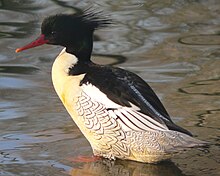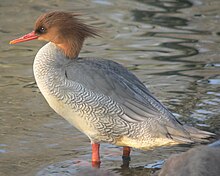Scaly-sided merganser
| Scaly-sided merganser | |
|---|---|

| |
| Adult male | |

| |
| Adult female | |
| Scientific classification | |
| Domain: | Eukaryota |
| Kingdom: | Animalia |
| Phylum: | Chordata |
| Class: | Aves |
| Order: | Anseriformes |
| Family: | Anatidae |
| Genus: | Mergus |
| Species: | M. squamatus
|
| Binomial name | |
| Mergus squamatus Gould, 1864
| |
The scaly-sided merganser or Chinese merganser (Mergus squamatus) is an
, breeding in the north and wintering in the south.Description
This striking
Ecology
Their breeding habitat is rivers in
This shy and easily startled bird favors mid-sized rivers which
They spend most of the daylight time foraging, except around noon when they take some time to rest,
Scaly-sided mergansers nest in trees, as typical for the
They are
Status
This
World population survey was completed in 2014 both in Russia and China, the number for North Korea was estimated without survey there. Surveys on dispersal wintering grounds are useless and the way to estimate world population is to survey pristine rivers within breeding range. Rivers of Central China, primarily tributaries of
Threats and conservation measures
Winter ecology and conservation threats to the scaly-sided merganser were reported in 2012. Threats include sand mining, fishing, riparian vegetation destruction, habitat fragmentation, and water pollution. Recommended conservation measures include provision of artificial nest boxes,[7] informing local residents of the merganser's status, fishing regulation, protection of critical habitat, controlling recreation on breeding rivers and the raising of domestic ducks in areas where the mergansers winter, management of hydrology in ways that protect and benefit the merganser, and annual population surveys at key breeding rivers.[8]
See also
- extinctwaterfowl from the same region
References
- . Retrieved 12 November 2021.
- ^ Solovyeva D.V., Liu P., Antonov A.I., Averin A.A., Pronkevich V.V., Shokhrin V.P., Vartanyan S.L., Cranswick P.A. 2014. The population size and breeding range of the Scaly-sided Merganser Mergus squamatus. Bird Conserv Int. 24: 393–405.
- ^ a b Zhengjie & Zhengjie (1998), BLI (2008), Solovyeva D.V., V. Afanasiev, J. W. Fox, V. Shokhrin & A. D. Fox. 2012. Use of geolocators reveals previously unknown Chinese and Korean scaly-sided merganser wintering sites. Endangered Species Research 17: 217–225.
- ^ a b c d Zhengjie & Zhengjie (1998) Solovieva, D.V. 2002. Foraging behaviour and daily time budget of Scaly-sided Merganser Mergus squamatus breeding on the Iman River, Russia. Wildfowl 53: 205–13.
- ^ Fen-Qi et al. (2002), BLI (2006, 2008), Solovyeva et al. 2014
- ^ Solovyeva, D.V., Vartanayan, S.L., & N. I-F. Vartanayan. 2013. Artificial nest-sites for Scaly-sided Merganser Mergus squamatus (Gould, 1864) – a way to breeding habitat restoration. Amurian zoological journal V(2): 201–207.
- ^ Shao, Mingqin; Zeng, Binbin; Tim, Hounsome; Chen, Lixin; You, Chaying; Wang, Hongbin; Dai, Nianhua. 2012. Winter Ecology and Conservation Threats of Scaly-sided Merganser Mergus squamatus in Poyang Lake Watershed, China. Pakistan J. Zool. 44(2): 503–510. Solovyeva D.V., Liu P., Antonov A.I., Averin A.A., Pronkevich V.V., Shokhrin V.P., Vartanyan S.L., Cranswick P.A. 2014. The population size and breeding range of the Scaly-sided Merganser Mergus squamatus. Bird Conserv Int. 24: 393–405.
- Fen-Qi, He; Melville, David; Xiao-Jie, Gui; Yuan-Hua, Hong & Zhi-Yong, Liu (2002): Status of the Scaly-sided Merganser Wintering in mainland China in the 1990s. Waterbirds 25(4): 462–464. doi:10.1675/1524-4695(2002)025[0462:SOTSMW2.0.CO;2] HTML abstract
- Zhengjie, Zhao & Zhengjie, Pao (1998): The foraging behaviour of the Scaly-sided Merganser Mergus squamatus in the Changbai Mountains and Xiao Xingangling Mountains of China. Forktail 14: 76–77. PDF fulltext
External links
- ARKive – images and movies of the scaly-sided merganser (Mergus squamatus)
- BIrdLife species factsheet. Retrieved 2007-JUN-12.

